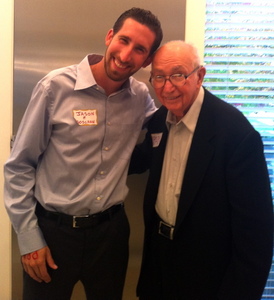
It’s a challenge to be taken one step at a time: Run a marathon — that’s 26.2 miles — while ascending part of The Great Wall of China — 5,164 vertical steps.
For Jason Boschan, it’s also an opportunity to try and raise $50,000 for primary progressive aphasia (PPA) research at the Cognitive Neurology and Alzheimer’s Disease Center (CNADC) of Northwestern University Feinberg School of Medicine. A little known disease, Boschan learned of the condition when his grandfather was diagnosed with it a few years back.
PPA was first identified as a distinct form of dementia in the early ’80s by Marsel Mesulam, MD, director of the CNADC. The condition, a “cousin of Alzheimer’s disease,” often occurs in individuals in their 50s and 60s, an age that physicians don’t usually associate with neurodegenerative diseases.
Unlike Alzheimer’s, which affects memory, PPA involves a decline in the ability to communicate, as nerve cells in the part of the brain that control language are destroyed. Although memory is not initially affected, 30 to 40 percent of patients with the condition are also diagnosed with Alzheimer’s. The remaining 60 percent suffer solely from frontotemporal labor degeneration, a disorder associated with atrophy of the brain.
“PPA is a disease that causes a slow and gradual impairment on the ability to find words,” said Mesulam, director of the CNADC. “The ‘tip of the tongue’ phenomenon that people experience from time to time is normal. In patients with PPA, it becomes more frequent and frustrating.”
Funded by a five-year grant from the National Institute on Deafness and Other Communication Disorders, the CNADC is continuing a comprehensive investigation that involves 77 PPA patients from 32 states and two Canadian provinces. The grant allows the CNADC to bring individuals living with PPA to Chicago for two days of neuropsychological testing, magnetic resonance imaging scans, and a daylong visit to the Evanston campus for language experiments.
PPA is a relatively rare neurological syndrome when compared to Alzheimer’s disease — Mesulam suspects tens of thousands of cases in the United States. It begins gradually and worsens to a point where understanding written or spoken language is lost.
“My grandfather’s life has changed pretty dramatically over the last couple of years,” Boschan said. “He had to stop practicing as a pediatrician, moved into an assisted living home, and his speech and mental comprehension skills have slowed down substantially. He is still able to understand many things which are said to him, and depending on the day, he responds quicker than others.”
The CNADC, along with three other National Institutes of Health Alzheimer’s Disease Centers (ADC), has specific PPA investigators, however each of the 30 ADC’s work with the condition on some level.
“These diseases are not killers, but they undermine the body’s resistance to other things that eventually cause death,” Mesulam said. “The important thing is what happens when patients are alive. A sometimes frustrating but full life can be had.”
The primary goal of treatment for individuals with PPA is to improve their ability to communicate. Because the types of language problems vary, the treatment options do as well. Some patients use communication notebooks, flash cards, gestures, or technological devices to interact.

A byproduct of the diagnosis is often an increased focus on hobbies like gardening, crafts, or other art forms. Some of that patient artwork was up for auction when Boschan, who lives in Charlotte, North Carolina, came to Chicago as part of a CNADC fundraising event on February 24. He also took part in the Hustle up the Hancock — 94 flights totaling 1,632 stairs — as part of his training for the marathon.
With about 80 days remaining before the Great Wall event on May 19, the 33-year-old Boschan had surpassed $38,000 in Run4Papa fundraising for the CNADC.
“One way or another, attention is being brought to Northwestern, the magnificent research team, and all patients and families battling this disease each and every day,” Boschan said, noting donations have ranged from $5 to several thousand dollars. “With awareness comes donations, with donations comes research, with research comes treatment, and with treatment comes a cure. Educating people about the disease through the fundraising process has been a remarkable experience.”
For Boschan, the chance to tell his grandfather’s story has provided an opportunity to better understand a condition of dementia that hadn’t had a global fundraising effort before. And because of that, the relationship he has with his grandfather has been made even stronger.
“He has been fully aware of this campaign from its inception and the other month told me that his legs couldn’t run the Great Wall,” Boschan said of his 86-year-old Papa. “I assured him mine would carry us both along this journey and help fight for other patients seeking a cure and more awareness for this disease locally, nationally, and internationally.”
To make an online gift, visit http://www.giving.northwestern.edu/nu/CNADC






